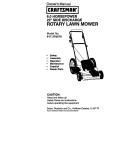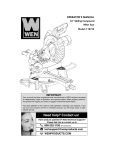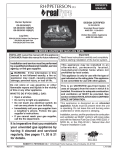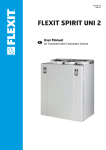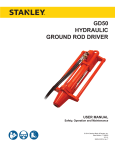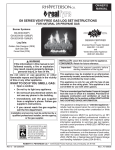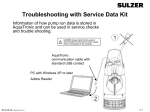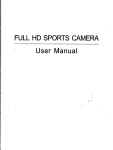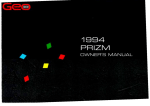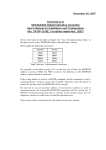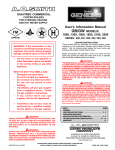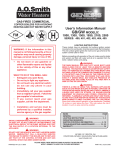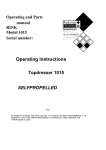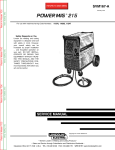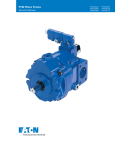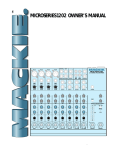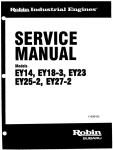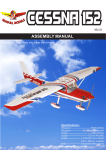Download "service manual"
Transcript
PRODUCTIVITY SERIES HYDRAULICS Table of Contents – Page 1 of 2 ABOUT THIS MANUAL SAFETY INFORMATION INTRODUCTION WHAT'S IN THIS BOOK? WHY SHOULD I READ THIS BOOK? THE BASIC PRINCIPLE OF HYDRAULICS BENEFITS OF HYDRAULICS HOW WE USE HYDRAULICS TERMS AND COMPONENTS HYDRAULIC TERMS - HYDRAULICS / HYDRODYNAMICS / HYDROSTATICS WORK POWER PRESSURE FLOW EFFICIENCY HYDRAULIC COMPONENTS - RESERVOIR FILTER PUMP - FUNCTION PUMPS - BY TYPE VALVE--FUNCTION VALVES--BY NAME ACTUATOR ACTUATORS--BY TYPE REVIEW SECTION #1 UNDERSTANDING CIRCUITS PROPERTIES OF LIQUIDS FORCE MAGNIFICATION BUILDING A BASIC CIRCUIT BUILDING A LIFT SYSTEM BUILDING A DRIVE SYSTEM THE REAL THING REVIEW SECTION # 2 SPECIFICATIONS EATON MODEL 7 EATON MODEL 11 EATON MODEL 781 HYDRO-GEAR 316-0500 HYDRO-GEAR 316-0750 PRODUCTIVITY SERIES HYDRAULICS Table of Contents – Page 2 of 2 SPECIFICATIONS - Continued HYDRO-GEAR BDP 10 ROSS MF SERIES WHEEL MOTOR SUNDSTRAND SERIES 15 TUFF TORQ K61A PROBLEM SOLVING STEP 1: ASK THE OPERATOR STEP 2: STUDY THE AVAILABLE INFORMATION STEP 3: INSPECT THE MACHINE STEP 4: OPERATE THE MACHINE TO VERIFY STEP 5: LIST THE POSSIBLE CAUSES STEP 6: TEST POSSIBLE CAUSES TEST EQUIPMENT INLET/OUTLET HOSE PRESSURE GAUGE FLOW METER/LOAD VALVE TEST EQUIPMENT NEEDS REVIEW SECTION # 3 REVIEW SECTION ANSWERS REVIEW SECTION # 1 REVIEW SECTION # 2 REVIEW SECTION # 3 ThissymbolmeansWARNINGorManualsandOperator'sManualsareavailablethrough PERSONAL SAFETY INSTRUCTION your local Toro distributor or by writing to: read the instruction becauseit has to do with your safety. Failure to comply with the instruction may result in The Toro Company death. even orpersonal injury Publications Department Aways read and follow the safety instructions provided 8111 Lyndale Avenue South in applicable the service manual operators or manual Bloomington, MN 55420 for the equipment you are working on. Service Avoid injury from high pressure oil Avoid Asphyxiation Never operate an engine in a confined area without Keep body and hands away from pin hole leaks or nozzles that eject high pressure oil. Use cardboard or proper ventilation. paper to locate hydraulic leaks. Oil escaping under high pressure can penetrate the skin and cause injury.Avoid injury from batteries Oil accidentally injected into the skin must be surgically removed within a few hours by a doctor familiar with Battery acid is poisonous and can cause burns. Avoid contact with skin, eyes and clothing. Battery gases can this form of injury or gangrene may result. explode. Keep cigarettes, sparks and flames away from the battery. Avoid unexpected starting of engine Always turn off the engine and disconnect the spark plug wire(s) before cleaning, adjusting or repairing. Avoid lacerations and amputations Avoid injury dueto inferior parts Use only original equipment parts to ensure that important safety criteria are met. Stay clearof all moving parts whenever the engine is running. Treatall normally moving parts as if they were moving whenever the engineis running or has the potential to start. Always clear the area of bystanders before starting or testing powered equipment. Avoid burns Avoid injury due to projectiles Avoid injuryto bystanders of sticks, rocks or any other Do not touch the engine, muffler, or other components Always clear the area debris that could be picked up and thrown by the which may increasein temperature during operation, powered equipment. while the unitis running or shortly afterit has been running. Avoid modifications Avoid fires and explosions Never alter or modify any part unless it is a factory approved procedure. Avoid spilling fuel and never smoke while working with any type of fuel or lubricant. Wipe up any spilled fuel or oil immediately. Never remove the fuel cap or add fuel Avoid unsafe operation when the engine is running. Always use approved, Always test the safety interlock system after making labeled containers for storing or transporting fuel and adjustments or repairs on the machine. Refer to the lubricants. electrical chapter later in this manual for more information. INTRODUCTION In What’s Why Should I Read This Book?.............................. 3 3 The Basic Principle of Hydraulics ............................ 4 Benefits of Hydraulics . . . . . . . . . . . . . . . . . . . . . . . . . . . . . . . . . . . . . 4 ................................... 5 How We Use Hydraulics TERMS AND COMPONENTS HYDRAULIC TERMS Hydraulics Hydrodynamics Hydrostatics ..................... Work . . . . . . . . . . . . . . . . . . . . . . . . . . . . . . . . . . . . . . . . . . . . . . . . . . . Power. . . . . . . . . . . . . . . . . . . . . . . . . . . . . . . . . . . . . . . . . . . . . . . . . . Pressure. . . . . . . . . . . . . . . . . . . . . . . . . . . . . . . . . . . . . . . . . . . . . . . . Flow . . . . . . . . . . . . . . . . . . . . . . . . . . . . . . . . . . . . . . . . . . . . . . . . . . . Efficiency . . . . . . . . . . . . . . . . . . . . . . . . . . . . . . . . . . . . . . . . . . . . . . . Function 6 7 7 7 8 HYDRAULIC COMPONENTS Reservoir . . . . . . . . . . . . . . . . . . . . . . . . . . . . . . . . . . . . . . . . . . . . . . . 8 Filter . . . . . . . . . . . . . . . . . . . . . . . . . . . . . . . . . . . . . . . . . . . . . . . . . . . 8 ......................................... Pumps-ByType . . . . . . . . . . . . . . . . . . . . . . . . . . . . . . . . . . . . . . . . . Valve-Function . . . . . . . . . . . . . . . . . . . . . . . . . . . . . . . . . . . . . . . . . ....................................... Valves Actuator . . . . . . . . . . . . . . . . . . . . . . . . . . . . . . . . . . . . . . . . . . . . . . . Actuators By Type . . . . . . . . . . . . . . . . . . . . . . . . . . . . . . . . . . . . . . 9 Pump By 6 REVIEW SECTION 1................................... 9 11 12 14 14 16 UNDERSTANDING CIRCUITS Properties Of Liquids . . . . . . . . . . . . . . . . . . . . . . . . . . . . . . . . . . . . . 17 ForceMagnification . . . . . . . . . . . . . . . . . . . . . . . . . . . . . . . . . . . . . . 17 Building A Basic Circuit . . . . . . . . . . . . . . . . . . . . . . . . . . . . . . . . . . . 17 .................................... Building A Drive System . . . . . . . . . . . . . . . . . . . . . . . . . . . . . . . . . . 19 21 ......................................... 21 Building A Lift System TheRealThing Productivity Series 1 . . . . . . REVIEW SECTION# 2 . . . . . . . . . . . . . . . . . . . . . . . . . . . . . . . . . . . 22 SPECIFICATIONS Eaton Model ........................................... 7 23 EatonModel11 .......................................... 23 EatonModel781 ......................................... Hydro-Gear316.0500 ..................................... 24 24 ..................................... Hydro-Gear BDP 10 ...................................... Ross MF Series Wheel Motor ............................... Sundstrand Series 15 ..................................... Tuff Torq K61A . . . . . . . . . . . . . . . . . . . . . . . . . . . . . . . . . . . . . . . . . . 24 Hydro-Gear316.0750 25 25 25 26 PROBLEM SOLVING Step 1: Ask The Operator.................................. 27 Step 2: Study The Available Information ...................... 27 Step 3: Inspect The Machine ............................... 28 Step 4: Operate the Machine to Verify........................ 28 Step 5: List The Possible Causes............................ 29 .............................. 29 Step 6: Test Possible Causes TEST EQUIPMENT Inlet/Outlet Hose......................................... 30 PressureGauge......................................... 30 Flow Meter Load Valve ................................... 31 Test Equipment Needs. . . . . . . . . . . . . . . . . . . . . . . . . . . . . . . . . . . . 31 REVIEW SECTION# 3 ................................... 32 ............................ 33 REVIEW SECTION ANSWERS Productivity Series 2 What's In This Book? This publicationis designed to familiarize the reader with basic hydraulics.It starts by defining common terms and components used with hydraulics. The components are then put together to show how they function in a hydraulic circuit. Once you are familiar with the basics, the book will review some of the systems that are used on Toro(R) equipment. A section on problem solving covers whatto do when you encounter a problem. Test equipmentis also reviewed to ensure you can properly diagnose and repair hydraulic systems. RADIAL BALL-PISTON HYDRAULIC PUMP VARIABLE DISPLACEMENT CHAR PUMP\ HYDRAULIC LIFT CONTROL VALVE. With 700 PSI RELIEF VALVE TRANSMISSION CHARGE PRESSURE 30-82 PSI IMPLEMENT LIFT System PRESSURE 700PSI For detailed service information on a specific unit, please referto the appropriate service and repair manual. This publication uses a building block approach. It is necessary to understand the information in the front of the bookto better understand information presented later. Review sections throughout the book include questions which involve the key concepts presented.If some questions are difficultto answer, review the information again before proceeding. Answers to the review questions are provided near the endof the book. Why Should I Read This Book? Hydraulics make up an important and expensive part of many of our products. Mis-diagnosing a problem causes frustration for you and your customer, not to mention unnecessary repair bills. of hydraulics Understanding the basic principles and the components usedin these systems will improve your ability to properly diagnose and repair hydraulic systems. The information presented in this book will give you the basic fundamentals neededto become an expert in hydraulics. 3 Productivity Series The Basic Principleof Hydraulics Hydraulics referto the useof liquids to transmit energy. In hydrostatic systems, mechanical energy from an external source is converted into hydraulic pressure. The pressure is then transferred through a circuit and re-converted into mechanical energy. In our products, the mechanical energy is supplied by an engine and the liquid used to transfer energyis oil. Benefits of Hydraulics Let's look atsome of the benefitsof using hydraulics to transmit power as compared to a mechanical system. Hydrostatic transmissions provide for infinite variation of output speed.A mechanical transmission is limited by thenumber of gear ratios it has. Hydraulic hoses or lines can be routed around corners.A mechanical system would require a complex belt, chain or gear system to accomplish this. I I The same fluid that transfers the energy also provides lubrication for moving parts. There is a greater need for lubrication between moving parts under heavy load. so With hydraulics, as the load increases, does the operating pressure. This automatically provides maximum lubrication during periodsof higher loads. Productivity Series 4 How We Use Hydraulics Applications for hydraulics are diverse throughout industry. With lawn and garden equipment, the main uses are to: 1. Propeltheunit 2. Lift implements attached to the unit 1.1311.19 5 Productivity The first stepin becoming comfortable with hydraulics is to learn the language. This section provides descriptions and examples of common hydraulic terms and components. We will first define some of the common terms used when working with hydraulics. Then we will describe the components which are included in many of the hydraulic systems you encounter. of the chapter will The review section at the end test your knowledge of the terms and components. HYDRAULIC TERMS Hydraulics Hydrodynamics Hydrostatics Hydraulics refer to applications of liquids in motion. Inall of our uses, liquids referto oil. Hydrodynamics refer to hydraulic systems which primarily use fluid flow to transfer energy. This includes applications such as a water wheel or a torque converter. Hydrostatics refer to hydraulic systems which primarily use fluid pressure to transfer energy. This includes applications such as a hydraulic lift system or fluid powered transmission. All of our applications involve hydrostatics. Work Work is the applicationof a force through a distance. For any work to be accomplished, movement is needed. Work is typically measured in foot pounds (ft Ibs). 5 Ibs Work Force X Distance Example: The same amount of work is done if a 5 pound objectis moved 10 feet or if a 10 pound object is moved 5 feet. I O Ibs 3.2714 Productivity Series 6 I HYDRAULIC TERMS (cont’d) Horsepower Power is done or Power is the rate at which work energy is transferred. Power is measured in foot pounds per second(ftlbs/sec). Power Work Time One horsepower is equalto 550 ftlbs/sec. Moving 55 pounds 10 feet in one second takes one horsepower. 55 Ibs In hydraulics,to transmit powertwo factors must be present; pressure and flow. 1 second Power Pressure X Flow Pressure Pressure provides the potential to transmit energy. Itis determined by the force across an area. Pressure is measured in pounds per square inch (psi). Pressure Force Area Ten pounds of force actingon one square inch provides 10 psi of pressure. Increasing the load on a hydraulic system will increase the operating pressure of the system. In a hydrostatic transmission, higher pressures will be generated going uphill as compared to going downhill. I I 3.4297.435 Flow Flow -measures the transfer rate (velocity) of a liquid passing through a given cross-sectional area. Flow is measuredin gallons per minute (gpm). Flow Area X Velocity Flow Volume Time The flow rate ofa hydraulic system determines the speed at which the system operates. Productivity Series Heat Rise Efficiency Efficiency describes the amount of power output from the hydraulic system as compared to theamount of power putinto it. Most hydraulic pumps and motors operate between 80% to 90% efficiency. The loss of power is made up by leakage and fluid friction. This friction causes a heat rise in the system. As a pump or motor wears internally, it becomes less efficient and the operating temperature increases. Power In Power Out + Heat Rise HYDRAULIC COMPONENTS Reservoir The reservoir is a simple, yet very important component of any hydraulic system.It serves as an expansion chamber, and separates trapped air from the fluid. Some systems use the gear case as a reservoir. This allows dirt and metal filings to settle outof the fluid. This typeof reservoir allows for more fluid capacity which in turn assists in keeping the system properly cooled. Reservoirs are generally vented and should prevent dirt or water from entering the system. How Big Is A Micron? 8 Microns Red Blood Cell 25 Microns White Blood Cell 0 Filter IFilter Hydraulic filters are special purpose filters which are ableto entrap extremely small particles of as dirt. A typical hydraulic filter will trap particles small as25 microns or less. Most engine oil 70 microns. filters only trap particles larger than Hydraulic filtersdo not have a bypass valve like an engineoil filter. When a hydraulic filter becomes clogged, oil flow is reduced and erratic operation will be evident. 100 Microns Grain Of Salt 70 Microns Human Hair 40 Microns Lower Limit Of Visibility 1 Micron 0.00003937" or 0.001mm Productivity Series a HYDRAULIC COMPONENTS (cont’d) Pump Function A pump is a device that transfers fluids by either suction, pressure or both.A pump converts mechanical energy into hydraulic pressure and flow. Pumps can either be fixed or variable displacement. HYDRAULIC A fixed (constant) displacement pump transfers a set amount of fluid during each revolution. To change the output, the speed at which the pump operates must be changed. A variable displacement pumpcan changeits output per revolution. Pumps By Type of pistons Axial Pistondesign pumps use a set rotating in a cylinder block. The cylinder block is rotated by the input shaft. The end of the pistons contact a swashplate. The swashplate may be a fixed angle (constant displacement) or adjustable to a range of angles (variable displacement). As the cylinder block rotates, the piston (either pulled by the swashplateor pushed by spring pressure) extends outof the cylinder block and draws oil into the chamber. On the opposite side, the swashplate forces the piston in, displacing oil from the baseof the cylinder block. I 3.4297.402 Radial-Ball Pistonpumps use several balls As the which travel through bores inside a rotor. rotor is turned by the input shaft, centrifugal force throws the balls out against a cam ring. Oil from a passage in the pintle flows into the chamber behind the ball. With the cam ring offset, the ballis pushed back into the boreas it rotates past the narrow side. This forces oil back into a second passage in the pintle. The cam ring offset can be either fixed to provide a constant output, or adjustable to provide variable output. 9 n HIGH PRESSURE OIL OUT LOW PRESSURE OIL IN Productivity Series An Internal Gear (Gerotor) pump uses two gears to provide a constant output of oil per revolution. The inner gear is offset from the pump’s center and is driven by the input shaft. A or rotor surrounds larger internal toothed gear the inner gear, providing a rotating mesh point to trap oil. True internal gear pumps usea crescent seal which provides a sealing area between both gears . Gerotor pumps utilize rounded teeth which do not requirea crescent for sealing. A Roller Bearingpump isa variation of the internal gear pump. Insteadof using two gears, rollers are placed between the teeth of the a Constant driven gear. This also provides displacement of oil. 1.1311. External Gear pumps usetwo tightly meshed gears to producea constant displacement ofoil per revolution. The input shaft drives one of the gears which in turn drives the second gear. The opposed gear rotation drawsoil from the inlet port and trapsit between the gear teeth and the pump body. As the teeth come together near the oil is forced outlet port, the area is reduced and out of the pump. 3.4297.405 Productivity Series 10 HYDRAULIC COMPONENTS(cont'd) A Charge Pump is a small constant displacement pump whichis driven by the input shaft. It provides a base circuit pressure and flow which can be used for the following functions: & Transferring oil from the reservoirto the hydrostatic pump & 4 Pushing oil through a system filter Supplying oilto remote lift cylinders - Valve Function Valves are usedto provide controlin a hydraulic system. They can be usedto control: & & & Pressure Direction Of Flow Volume Of FIOW We will first review these three functions of valves and then review some of the common types of valves you may encounter. Pressure Controlvalves may be usedto provide an upper pressure limit or to maintain a minimum pressure in a circuit. For an example, let'slook at a lift system. High pressure is generated when objects heavier than the system design are encountered or when a cylinder reaches the end of its stroke. The pressure control (relief) valve opens when the upper pressure limit of the system is reached. With the valve open, a pressure escape path routes the oil back into the low pressure side of the circuit, protecting the system components from damage. 3.4297.407 11 Productivity Series Directional Valvesare usedto control the direction or pathof fluid flowin a hydraulic system. This may consist ofa check valve preventing backflow through a line or a spool valve diverting the fluid’s path to a remote cylinder. 3.4297.4 Flow Control valves are usedto regulate flow into or out ofa hydraulic component. With a lift cylinder, a flow control valve can control the rate at which oil enters or leaves the cylinder. This allows the speed at which the cylinder extends or retracts to be regulated. With a transaxle, a flow control valve may restrict flow through a passage completely during normal operation, but when activated, allow oil to pass throughso the unit can be hand pushed. 3.4297.409 Valves By Name Acceleration Valve An acceleration valveis a special flow control valve used in some hydrostatic transmissionsto smooth changesin speed or direction.A common wayto do thisis by temporarily allowing some oil to escape from the high pressure side to the low pressure side of the pump/motor circuit. I Productivity Series I One example of an acceleration valve usesa small metering hole which slowly allows high pressure oil to enter the cavity behind the valve. As the cavityis filled, the valve advances and closes the passage between the high and low pressure circuits. 12 HYDRAULIC COMPONENTS(cont’d) - Check Valve A check valve can be used for pressure control or directional control. It usually consists of a ball andseat area. A spring may be used to hold the ball on the seat. Some check valves are adjustable. This is accomplished by using a spring with a different rate, shimming the existing spring or compressing the spring with a threaded adjuster. I I I 3.4297.4111 Push Valve - A push valveis a flow control valve usedto open a pump/motor circuit. Manually opening the circuit allows oil to bypass from one sideof the circuitto the other or allows oil toescape back to the reservoir. The push valve allows the unit to be moved without starting the engine. Most, but not all hydrostatic transmissions use a push valve. 3.4297.412 Relief Valve- A relief valveis a pressure control valve which is used to protect a hydraulic circuit from pressures which are higher than the circuit’s design. 3.4297.413 13 Productivity Series Spool Valve A spool valveis a directional valve usedto control oil flow. There aretwo types of spool valves: open center and closed center. Both types allowoil flow to be diverted to a remote circuit when the spool is not centered. A closed center spool valve stops flow from the pump when it is centered. This typeof valve is not used with a positive displacement pump. OPEN CENTER An open center spool valve allows oil from the pump to pass through the valve when the spool is centered. CLOSED CENTER 3.4297.41 HYDRAULIC PRESSURE Actuator A hydraulic actuatoris a device which converts hydraulic pressure and flow into mechanical energy. Thetwo most common types of actuators are hydrostatic motors and hydraulic cylinders. Actuators By Type A Motor is simply a pump used backwards.It takes hydraulic pressure and flow from a pump and converts it back into rotary mechanical energy. Due to their similaritiesin function, many motors use designs similarto pumps. In some cases, the exact same configuration can be used as a pump or motor. Productivity Series 14 HYDRAULIC COMPONENTS (cont’d) Hydraulic Cylinder A hydraulic cylinder converts hydraulic pressure and flow into linear mechanical energy. I t consists of a sealed chamber, piston, and piston rod. Cylinders can be either single action or dual action. CHAMBER PISTON PISTON ROD 3.4297.417 Single Action Cylinder Single action cylinders can only be powered in one direction. Gravity or spring pressureis used to retract the cylinder after extension. These cylinders comein two different styles. The typical version has a hydraulic line connected on one side of the piston andis vented to the atmosphere on the opposite side. A displacement cylinder uses a large shaft called aram which replaces the piston and piston rod. It can be serviced externally and eliminates the need for an atmospheric vent. 3.4297.418 Dual Action Cylinder A dual action cylinder can be filled with oil on either sideof the piston. To extend the piston rod, oil is forced into the bottom endof the cylinder and oil ahead of the piston is pushed out of the cylinder. During retraction, this processis reversed, allowing the piston rod to be powered in both directions. r A typical double action cylinder can exert more force during extension than it can during retraction. Thisis because the piston rod takes away from the piston surfacearea usedto retract the cylinder. Force Pressure X Area I 15 3.4297.419 Productivity Series 1 . In hydraulic systems, .- energy from an external source is converted into hydraulic and flow. 2. As the load onhydraulic a system 3. is increased, the operating increases. refer to hydraulic systems which primarily use fluid pressure transfer to energy. 4. Work is the application of a force through a 5. Power is the rate at which 6. Flow is usually measured 7. external An gear pump is done or energy in is a is transferred. per displacement pump. 8. List the three functions thata valve may perform. 1. 3. 9. A hydraulic actuator converts hydraulic pressure and flow into powered beonly cylinder 1O.A can Productivity in direction. one Series 16 Properties Of Liquids A liquid has noshape, it always assumes the shape of its container. Unlike air, liquids compress only slightly under pressure. A force applied to a contained liquid will exert equal pressurein all directions within the container. 3.4297.420 Force Magnification To gain a mechanical advantage, the sizeof the ends of the container canbe varied. Example::The pump hasan area of 1 square 10 square inch. The cylinder has an area of inches. If 10 pounds of force is applied to the pump, 100 pounds of forceis exerted on the cylinder. If the amount of work putinto the system equals the amount of work outof the system[I00% efficient], the pump will travel 10 times farther than the cylinder. 3.4297.421 Building A Basic Circuit Let’s put together a simple circuit using some basic hydraulic components. We will start out with a simple pump and cylinder connected by a line. As you can see,there aresome flaws in this design. There is not extra oil so that the pump can continue raising the cylinder after the first stroke. Also, when the pump handle is raised, the cylinder drops. 3.4297.422 17 Productivity Series The flaws can be corrected by installing a reservoir and two check valves. One check valve will keep oil from being forced back into the reservoir and the second will keep oil the under the cylinder when the pump handle is raised. When the pump armis raised, the surface area of the chamber between the check valves increases. As the area increases, pressure acting on the surfaces inside the chamber decreases. When the pressurein the reservoir becomes greater than the spring pressure on the check valve and the pressure in the chamber; the check valve movesoff its seat. As oil flows into the chamber, the pressure begins to increase. As the handle is pushed downward, the pressure inside the chamber increases and closes the check ball under the reservoir. The second check ball now opens allowing the oil to flow into the chamber under the cylinder ram. 3.4297.424 The force neededto extend the cylinder ram is dependent on the amount of weight on the ram. A five pound weight requires five pounds of of the force to lift. Because the size (area) cylinder can not be changed, adding more weight to the cylinder requires a higher pressure to achieve movement. When the pump reaches the end of its stroke, pressure under the pump and cylinder equalizes, allowing the check valve to close and trapping the oil under the cylinder. 3.4297.425 Productivity Series 18 Building A Basic Circuit (Cont’d) This cycleis repeated until the cylinder ram is fully extended. Notice in the simplifiedsystem, To accomplish this, the ram can not be let down. we need to add a second valve under the cylinder. This valve should not open unless the pressure capacityof the systemis met or it is A manually opened to let the cylinder ram down. return line will direct the oil from the cylinder back to the reservoir. 3.4297.426 Building A Lift System Let’s replace the hand pump with an external gear pump whichis capable of providing constant displacement and more flow. By placing thepump in-line, we no longer need the check valves to provide directional control. The greater output of this pump will extend the cylinder much faster. When the cylinder ram reaches the endof its stroke, pressure will increase and open the relief valve. 3.4297.427 If we replace the single action cylinder with an open center spool valve and a dual action cylinder, we have a basiclift system. When the spool valveis centered, the oil passes directly through it and returns to the reservoir. 3.4297.428 19 Productivity Series When the spool valveis offset, oil is directed into the bottom end of the cylinder and the piston rodis extended. Notice thatoil from the opposite sideof the piston also passes through the spool valve and back to the reservoir. I 3.4297.4:29 When the pressurein the cylinder reaches the setting of the pressure relief valve, the valve opens and directs the oil flow backto the reservoir. This happens when a high resistance is met, such as the cylinder reaching the end of its”stroke. I I 3.4297.430 When the spool valveis offset in the opposite direction, theoil flow through the valve and cylinder is reversed. I I 3.4297.431 Productivity Series 20 Building ASystem Drive Let’s replace the cylinder with another type of actuator a fixed displacement hydraulic motor. With the motorin place, this system will provide the continuous mechanical energy output needed to propel lawn and garden equipment. This system can reverse the direction of travel by changing the spool offset and reversing the oil flow through the motor. Notice that there is nothing in this system that will allow the output speed to be changed. Our hydrostatic drive systems use a variable displacement pump and a fixed displacement motor. With variable output from the pump, the spool valve is no longer needed to control the direction of oil flow. The speed can also be changed with this variable output pump. 3.4297.433 The Real Thing If we combine the drive system with the lift system we had previously, the resultis a hydraulic system similar to systems on many of the larger tractors in use today. I Productivity Series 1. Under load, which pressure gauge(A or B) below will indicate the most pressure? 2. If both circuits below have the same amountof pressure applied to them, which circuit(A or B) is capable of lifting more weight? 3. Which valve (A, B or C) in the circuit below is responsible for protecting the system from high pressure? Productivity Series 22 We use several different hydraulic systems across our product line. Allof these systems are made from the basic components described earlier and operateby using the fundamental principles of hydraulics. Eaton Model 7 This hydrostatic transmission has a variable radial-ball pistonpump and fixed displacement radial-ball motor.Maximum pump outputis 0.465 cu. in.(7.62cc) per revolution. The motor output is 0.767 cu.in (12.57 cc) per revolution.It does not use a charge pump. A fine screen at the bottomof the reservoir provides for filtration of incoming oil. This unit must be coupled to a final drive to provide power to the drive wheels. 1.1311.2 Eaton Model11 The Eaton 11is similar to the model7 but is considerably larger and uses an auxiliary charge pump. The pump displacesa maximum of 1.15 cu.in.(18.85cc) per revolution and the motor has a 2.09 cu. in. (34.25 cc) displacement per revolution. The charge pump supplies a maximum flow of 1.5 gpm (5.7l/min) [0.10cu. in. per revolution (1.6cchev)] and can provide power for a hydraulic attachment lift. This system is used with a separate filter and reservoir. Again, this unit must be coupled to a final driveto power the drive wheels. 1.1311 23 Productivity Series Eaton Model 781 This transaxleis used as a pair(RH & LH) to make up a complete drive system. It has a variable radial-ball pistonpump and fixed displacement radial-ball motor. Maximum pump output is 0.465 cu.in.(7.62cc) per revolution. The motor outputis 0.767 cu. in. (12.57 cc) per A revolution. It does not use a charge pump. remote expansion tankis used for a reservoir with a fine screen at the bottom of the inlet line providing the filtrationof incoming oil. Two sets of planetary reduction gears provide power to the axle. 1.1311.3 Hydro-Gear 316-0500 This is a typical hydrostatic transaxle used in a lawn tractor It is completely self-contained and has its own differential. This transaxle utilizes a variable axial piston pump with a maximum displacement of 0.61 cu. in. (10 cc) per revolution. The motoris also an axial piston design with a fixed displacement of 1.28 cu. in. (21 cc) per revolution. 1.1311.5 Hydro-Gear 316-0750 This hydrostatic transaxleis similar to the 316-0500. It uses a heavier differential to handle higher loads. This transaxle utilizes a variable axial piston pump with maximum a displacement of 0.61 cu. in. (10 cc) per revolution. The motor is also an axial piston design with a fixed displacement of 1.28 cu. in. (21 cc) per revolution. 1.1311.6 Productivity Series 24 Hydro-Gear BDP 10 This pump is a variable output axial piston design with a maximum output of 0.61 cu. in. (10 cc) per revolution. This pump uses a gerotor charge pump to pre-charge the system. This is usedin a separated pump and wheel motor system. Hydraulic lines connect the pump with a wheel motor. Ross MF Series Wheel Motor The Ross wheel motor is an internal gear (gerotor) design. The displacementis 12 cu. in./rev (196.7cc/rev. A separate pumpis used to provide the pressure and flow to this motor. A small displacement pump is used to drive the wheel motor. The pump must complete several revolutions to displace enough oilto drive the wheel motor through one revolution. This provides a speed reduction similar to using reduction gears in a mechanical transmission. 1.1311.111. 31 .1 Sundstrand Series15 The Sundstrand Series 15 uses an axial piston variable pump with a fixed displacement axial piston motor. The maximum pump output is .91cu. in. (14.9 cc) per revolution and the motor displacement is .91cu. in. (14.9 cc) per revolution. An internal gear (gerotor) charge pump provides 4.6 gal/min(17.4l/min). [.33cu. in. per revolution (5.4cchev)] flow for use with a hydraulic attachment lift. 1.1311.8 25 Productivity Series Tuff Torq K61A This transaxleis completely self-contained andhas its own differential. It utilizes a variable axial a fixed displacement axial piston pump and with piston'motor. An internal spring assists in returning the control arm to neutral. A dampening pistonis used on the motion control input arm to smooth directional changes. 1.1311.7 Productivity Series 26 Using a systematic approach makes hydraulic troubleshooting easy. By following a process which narrows down the possible causes, a problem can be pinpointed and confirmed. Step 1 : Ask the Operator Step 2: Study the Available Information Step 3: Inspect the Machine Step 4: Operate the Machine to Verify Problem Step 5: List the Possible Causes Step 6: Test Possible Causes Step 1:Ask The Operator A detailed problem description is a valuable diagnostic tool during troubleshooting. Has there been oilloss from the system? What type of terrain (slope) was the product used on? How was the unit being used? How warm was the fluid? What type of maintenance has been performed? Did anything unusual happen before the problem occurred? Example Complaint Lift system doesn’t work. Can not get the deck to raise. Problem Description Hasn’t noticed oilloss. Used on fairly flat yard for mowing only. Same operationif hydro cold or warm. Use 5 seasons - never serviced Answers to these questions should be recorded on the work order. Step 2: Study The Available Information Review the technical information which applies to the hydraulic system you are working with. Flow diagrams will show which types of components are involvedin the system. Can the problem be related to a particular circuit or partof a circuit?Does the problem seemto be pressure related? Does the problem seem to be relatedto oil flow? What components are controlling these conditions? Circuit Involves Charge Pump Spool Valve Lift Cylinder Filter Lines & Fittings Control Linkage forspool valve Be sure to check for Service Bulletins which may apply to this system. 27 Productivity Series Inspection Results Oil is fairly clean- no signs of water or overheating Spool valve works smooth Hydro is clean Hoses appear in good shape Does not apply- unit drives great so the problemis in thelift circuit. Drive operationOK Engine runsOK. Lift system does not work. Seems like it tries to raise deck. Noisy when spool valveis off center. Step 3: Inspect The Machine Its now timeto collect physicalevidence. Again, take notes on what you see. Inspect the the oilin the unit. Is the oil level correct? Does it look black(Dirt)? Does it look milky (Water)? Does it smell burnt( Overheated)? Are there bubbles in the reservoir (Airleak)? Inspect the outsideof the hydraulic system. Does the control linkage work properly? Does it have full travel?Is it secure? Is there debris around the hydraulic components? Are thehoses/lineskinked? Are there any signs of leakage? Inspect the drive, for the system. look normal? Are Does the input drive line there signsof slippage in the system? . Inspect the output drive Does everything seem secure? Are the drive keys in place? Can you push the unit without activating the push valve? Step 4: Operate the Machine to VerifyIf the machinestill operates, use the detailed problem descriptionto verify what the operator experienced. Use circumstances similar to those provided in the problem description to reproduce the problem. While operating the unit, note anything that may affect the hydraulic systems operation. How well does the engine run? Do the brakes work properly? Are there any belts slipping? Do the controls work smoothly? Does the system operate properlyin one direction and not the other? Be sure to record all your observations. Productivity Series 2% Step 5: List The Possible Causes Make a listof the possible causes for this problem. Use your notes to support your conclusions. Which causes best match the description of the be easily verified? problem? Which causes can Step 6: Test Possible Causes Using the technical information and the proper test equipment, test the possible causes to verify your conclusions. Start with the items on your list which are the easiest to check. If it is not be possible to pinpoint the problem to one component, an internal inspection will be necessary. 29 Possible Causes Charge pump failing- low output Internal cylinder leakage Spool valve problem Hose kinked Relief valve problem Spool valve linkage Check The Easy ThingsFirst Hose kinked easy Spool valve linkageeasy Charge pump failing - low output Relief valve problem Internal cylinder leakage Spool valve problem Productivity - To properly troubleshoot many hydraulic systems, it is necessary to measure the pressure andor flow at various pointsin the system. This can only be done by using the proper test equipment. if there Service and repair manuals will indicate are specific tests which can be performed aon specific hydraulic system. The amount of pressure andor flow the system should be generating will determine the size and type of the equipment needed. Inlet/OutletHose Hoses are used to connect your test equipment' into the system you are testing. The hoses should be rated higher than any pressure that may be reached during testing. They should also be long enough to allow for easy readingof be the test equipment. Adapter fittings may needed to attach to different systems. 1.1311.14 Pressure Gauge As you might expect, pressure gauges are used to measure the pressures experienced during certain phasesof circuit operation. A good quality pressure gaugeis usually liquid filled to stabilize the needle. Low pressure 0 to gauges for hydraulic testing will read from 1000 psi (70.3 kg/sq cm). A high pressure 0 and gauge normally allows for testing between 5000 psi (351.3 kg/sq cm). 1.1311.15 Productivity Series 30 Flow Meter Load Valve Flow Meters are usedto measure the actual flow in a circuit during operation. The meter is placed inline and will indicate flow in gallons per minute (gpm). A Load Valveis a flow control valve which can be used during testingto simulate a load.As the flow is restricted, a higher loadis simulated. Load valves are usually used in combination with a flow meter. 1.1311.16 Test Equipment Needs The type of test equipment you need depends on the typeof equipment being servicedin your shop. Generally, test gauges can be adapted to many different systems simply by using adapter fittings. Your test equipment should be capable of handling pressures greater than the pressure generated by the largest system you will need to test. 1.1311.20 A liquid filledgauge capable of 1000 psi (70.3 kg/sq cm) will be sufficient for testing hydraulic systems on TORO Wheel Horse riding products. Some systems used onTORO ProLine equipment require a flow meter capable of measuring at least7 GPM. A high pressure gauge may also be needed. When performinga traction teston a ProLine 220, pressuresin excess of 4000 psi (281 kg/sq cm) will be experienced. 31 I Product Pressure Gauge High Pressure Gauge Flow Meter Load Valve Tractors Lawn ProLine Mid-Size ProLine 100 Productivity Series 1. The first step in problem solving is to: A. Study the available information B. List the possible causes C. Inspect the machine D. Ask the operator E. Operate the machine to verify the problem 2. Oil which looks milkyis most likely contaminated with: A. Milk 8. Dirt C. Water D. Transmissionfluid E. Nothing 3. An indicator of an overheated hydraulic system is: A. Burnt smelling fluid B. Oil loss in the system C. Loss of power as the system warms D. Air bubbles in the reservoir E. Black colored oil 4. Whentestingthepossiblecausesofahydraulicsystemproblem,alwaystestthepossibilities first. 5. Whenusingaloadvalveduringtesting,asflow 6. Thetestequipmentused is restricted,ahigher is simulated. in yourshopshouldbecapableofhandlingthegeneratedbythe largest hydraulic system you will need to test. Productivity Series 32 Review Section 1 1. mechanical,pressure 2. pressure 3. Hydrostatics 4. distance 5. work 6. gallons,minute 7. fixedconstant 8. Pressure Control, DirectionOf Flow, Volume Of Flow 9. mechanicalenergy 10.single action Review Section# 2 1. Both gauges will read the same amount of pressure because they arein the same circuit. 2. Circuit A - Force is equal to pressure times the area on which it is acting. The pressure is the same in both circuits. The cylinder in circuit A is larger than the cylinderin circuit The same pressure times a larger area will generate the most force. 3. Valve C - Valve A is a check valve which keeps oils from returning to the reservoir during pumping. Valve B keeps the oil trapped under the lift cylinder. Valve Cis used as a pressure relief valve and as a flow control valve to let the cylinder down. Review Section 3 1. D 2. c 3. A 4. easy 5. load 6. pressures f- This Productivity Series Manual was written as a training guide for service technicians. Learning the fundamentals of a subject is a necessary step in becoming an expertin any area. This publicationis designed to increase the readers knowledge on hydraulics. The Toro Company has made every effort to make the informationin this manual complete and correct. We are hopeful that you will find this manual a valuable addition to your service shop.If you have any questions or comments regarding this manual, please contact us at the following address: The Toro Company Consumer Service Training Department 8111 Lyndale Ave. S. Bloomington, MN 55420 The Toro Company reserves the rightto change product specifications or this manual without notice. Copyright@All Rights Reserved 994 The Toro Company






































